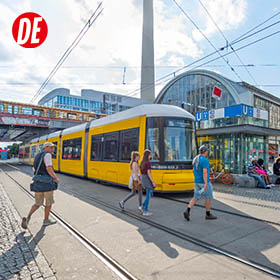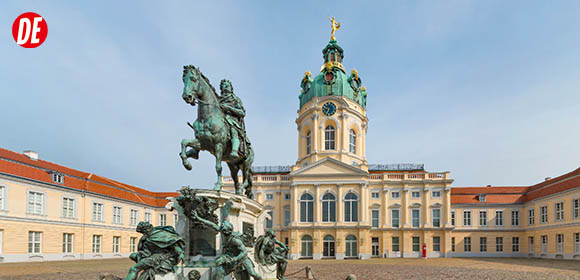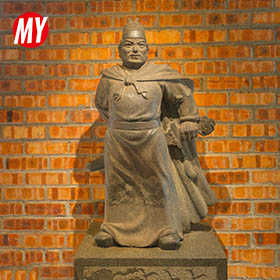
As the capital of Germany, Berlin enjoys the glory of the Kingdom of Prussia and the German nation, and is also guilty of the genocide of Nazi Germany. The Brandenburg Gate, the Reichstag and the Charlottenburg Palace have not survived the war, and it is not only the city that has been rebuilt, but humanity as well.
Landmarks and Plazas in Berlin
The most iconic architectures in a city need to have a certain number of elements, such as a long history, an ill-fated past, an outstanding appearance, a profound significance… Berlin has no shortage of such buildings, and they meet almost all of the criteria listed above. The Brandenburg Gate and the Reichstag are just a few examples.

Brandenburg Gate And Pariser Platz
Symbol of German Reunification
The Brandenburg Gate is located in the heart of Berlin, with Pariser Platz on the east side being the start of the Unter den Linden Boulevard. The Brandenburg Gate was first built in 1788, and this neoclassical building is the only remaining gate in Berlin, witnessing historic moments such World War II, and the unification of East and West Germany.

Reichstag Building
The Fall of Nazi Regime
The Reichstag is one of Berlin's most iconic landmarks, with its Renaissance-style exterior and modern glass dome. The Reichstag was first built in 1894, has undergone arson and bombing, then restored to house the German Federal Parliament.
Almost every city in Europe has one or two large squares, and Berlin is no exception. Potsdamer Platz, Pariser Platz, Alexanderplatz, Gendarmenmarkt, Bebelplatz… Most of the squares and surrounding buildings were seriously damaged during World War II and are now reappearing in front of us with a new look.

Potsdamer Platz
Rise From Post-War Ruins
Potsdamer Platz is located one kilometer south of Berlin's Brandenburg Gate, with its shopping malls, high-end hotels, cinemas, theaters, and casinos, is one of Berlin's key business districts. Potsdamer Platz was once in ruins after World War II, and still has remnants of the Berlin Wall.

Alexanderplatz
Commercial Center of East Berlin
Berlin's Alexanderplatz was once the commercial center of the GDR and was named in honor of the visit of Tsar Alexander I of Russia in 1805. Alexanderplatz is surrounded by large shopping malls, as well as landmarks such as the Berlin TV Tower, the World Clock and Berlin City Hall.

Gendarmenmarkt
Three Historic Buildings
Gendarmenmarkt is a square in Berlin where Frederick William I stationed troops in 1736. There is a statue of Schiller in the center the square, surrounded by the Konzerthaus Berlin, the French Church and the German Church, all of which were restored and repaired after World War II.
Berlin Wall
A wall has been erected along the border between East and West Germany for 40 years; a wall has separated friends and relatives of the same blood; a wall has destabilized the global situation. In 1989, this 167.8-kilometer-long Berlin Wall finally came to an end.

Berlin Wall
The Iron Curtain
After the Second World War, East Germany built a 167-kilometer-long Berlin Wall on the border between the two German states, which was not opened until 1989. The East Side Gallery, the Berlin Wall Memorial Park and the Topography of Terror are three of the major remnants of the Berlin Wall.
There are three relatively intact sections of Berlin Wall in the city of Berlin, and Checkpoint Charlie, a border post in the past, to remember this period of History of the Cold War.

Checkpoint Charlie
Best-known Berlin Wall Crossing Point
Checkpoint Charlie began in 1961 as a border post between East and West Germany during the Cold War and was dismantled after the fall of the Berlin Wall in 1990. The rebuilt Checkpoint Charlie is a popular tourist attraction in Berlin, where visitors can pay to have their picture taken with actors dressed in American military uniform.

East Side Gallery
When Graffiti Arts Meet Berlin Wall
The East Side Gallery, 1.3 kilometer long, is the best-preserved section of Berlin Wall. After the fall of the Berlin Wall in 1990, artists from different countries have created more than 100 works on this section of the wall, which is now the most popular art exhibition area in Berlin.

Berlin Wall Memorial
High Walls, Barbed Wires and Watchtowers
A 200-meter-long section of the Berlin Wall remains in Berlin's Bernauer Straße, along with watchtowers, lampposts and ruins, which are collectively known as the Berlin Wall Memorial Park, together with the nearby Berlin Wall Memorial, Documentation Center, Chapel of Reconciliation and others.

Topography Of Terror Documentation Center
Gestapo and SS Headquarters
The Topography of Terror is a Berlin museum of Nazi crimes committed during the Third Reich, built on the site of the former headquarters of the Nazi Gestapo and SS. Including a 200-meter-long section of the Berlin Wall and the remains of buildings.
Charlottenburg Palace
Located in the western part of the city, Charlottenburg Palace is the largest surviving palace in Berlin, with royal buildings such as the Old Palace, the New Wing, the New Pavilion, the Mausoleum, the Tea house “Belvedere”, and a relaxing Charlottenburg Palace Garden.
Charlottenburg Palace will give you an insight into the life of the Prussian royal family: the king’s bedchamber, the queen’s living quarters, the splendid banqueting hall, and the rococo parlor.

Charlottenburg Palace
Baroque-style Palace with Gardens
Charlottenburg Palace was built at the end of the 17th century and named after Queen Sophie Charlotte, the wife of King Frederick I. It is the largest existing palace in Berlin, including the Old Palace, New Wing, New Pavilion, The Mausoleum, the Belvedere, and a palace garden.

Charlottenburg Palace - Old Palace
Magnificent Prussian Palace
The Old Palace is the main exhibition area of the Charlottenburg Palace in Berlin, first built at the end of the 17th century and first owned by King Frederick I and Queen Charlotte. The Porcelain Cabinet and chapel in the Old Palace reflect the life of the royal family. There is an exhibition of royal collections of gold, silver and crowns.

Charlottenburg Palace - New Wing
Unforgettable Rococo-style Decor
Between 1740 and 1745, Frederick the Great of Prussia added a new wing to the east side of the Old Palace of Charlottenburg Palace. In the New Wing there are several rooms decorated in the rococo style, two banqueting halls, the Golden Gallery and the White Hall, as well as the living quarters of the members of the royal family.

Charlottenburg Palace - New Pavilion
Summer House in the Palace Garden
The New Pavilion of the Charlottenburg Palace in Berlin is located in the palace garden, next to the New Wing. Built in 1825 as a summer residence by Friedrich Wilhelm III, the New Pavilion exhibits paintings and artworks by local artists.
Attractions in Berlin
- Brandenburg Gate And Pariser Platz
- Reichstag Building
- Potsdamer Platz
- Berlin Wall
- East Side Gallery
- Checkpoint Charlie
- Unter Den Linden
- Museum Island Berlin
- Charlottenburg Palace
- Charlottenburg Palace - Old Palace
- Charlottenburg Palace - New Wing
- Charlottenburg Palace - New Pavilion
- Memorial To The Murdered Jews Of Europe
- Berlin Victory Column
- Gendarmenmarkt
- Alexanderplatz
- Kaiser Wilhelm Memorial Church
- Topography Of Terror Documentation Center
- Berlin Wall Memorial




































